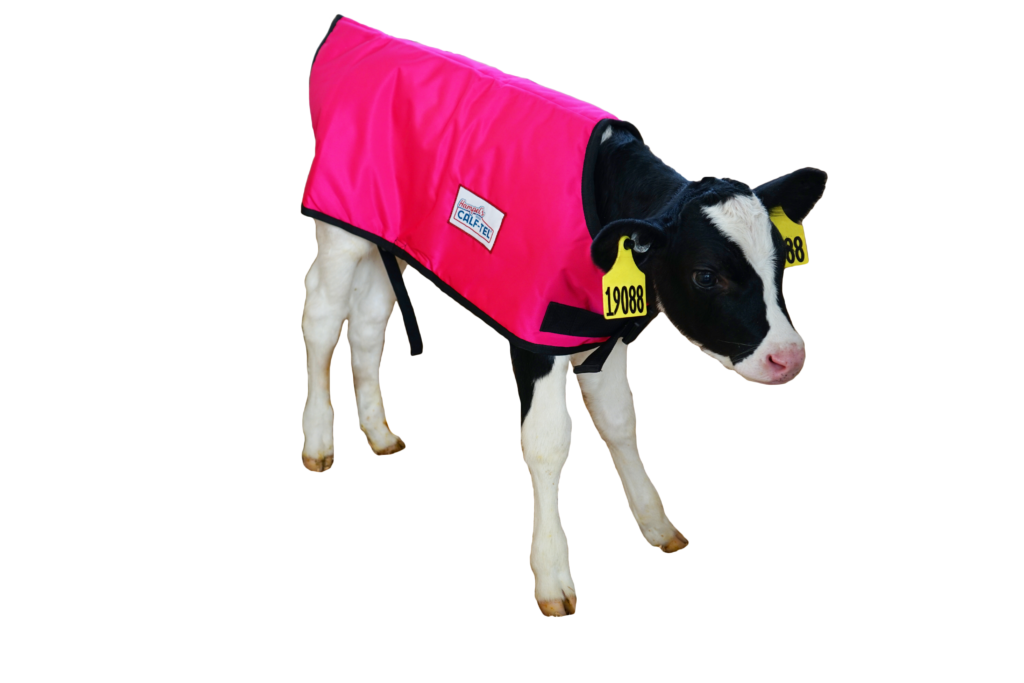
While calf jacket use varies depending on your location, climate, and management practices, the following information will provide you with valuable tips on:
- How and why to use calf jackets
- How to care for calf jackets
- How to choose the best calf jackets
Why use a calf jacket?
Calf jackets, also referred to calf coats, are a cost-effective tool that helps prevent cold stress in calves. Calves have a temperature range where they are considered to be comfortable, known as the “thermoneutral zone”. For a newborn Holstein calf, this zone is between 50 and 78°F (10 to 25°C). If a calf’s temperature goes above or below these temperatures, the calf will divert its energy from growth and immune function towards maintaining its core body temperature.
How to properly use a calf jacket
- A jacket can be used when outside temperatures dip to 50 degrees F (10°C). Cold stress begins when temperatures drop below 60°F for calves less than 21 days of age and when temperatures drop below 50°F for calves greater than 42 days of age.
- Jackets are highly recommended on newborn calves up to three weeks of age and for calves suffering from illnesses as a way of ensuring they aren’t using all available energy just to stay warm.
- First, make sure the calf has dry, clean, deep bedding it can nest down into. In the first few weeks, newborn calves spend most of their time lying down. A good way to know if the bedding is dry enough is to kneel in the bedding for a few minutes. If your knees are damp or wet, then the bed is not dry enough to eliminate additional cold stress. This can lead calves to spend more time standing, exposing more body surface to heat loss.
- The calf’s natural hair coat should be clean and dry before putting on a jacket. Newborn calves should have time to dry before being moved to an outdoor hutch or indoor pen. As the temperature drops, any moisture trapped under the jacket will cause the calf’s body temperature to lower further.
- Ensure calves are not sweating while wearing calf jackets during the day. Again, as temperatures drop the moisture will cause a decrease in the calf’s temperature.
- The jacket should be snug, not tight. We recommend just loose enough to slide your hand under the jacket. Be certain to adjust the straps at the front chest and rear legs every week to accommodate the growing calf and avoid the natural hair coat from rubbing off.
How to maintain and care for a calf jacket?
- Jackets should be regularly machine washed and dried to reduce the spread of bacteria. High quality calf jackets, like those from Calf-Tel, are well insulated.
- Insulation works by trapping air molecules between the calf and the outside air. The more air the insulation is able to trap, the better the insulation will be. If the jacket is compacted with soiled material, then the insulation may not work effectively.
- Calf jackets should be stored in a clean dry location ready for use.
How to choose the best calf jacket for you?
There are many types of jackets to choose from. Here are some of the key factors to consider when choosing the best calf jacket for you and your calves.
- Straps & Fasteners:
- Straps should be long enough to allow for use on large and small calves as they grow.
- Most jackets use either Velcro or plastic buckle fasteners. Velcro is cost effective but can become clogged and matted with debris.
- Plastic buckles ensure a secure fastening, adjustable strapping and are long lasting.
- Material: Calf jackets are used in harsh conditions and should be durable enough to withstand normal day-to-day conditions and multiple washings. A water-repellant shell on the jacket also helps keep both the calf and jacket drier in outdoor settings.
- Insulation: Insulation is what keeps the calf warm. Calf jackets should be properly insulated with material that is densely woven, preferably 200g or more, thick and durable.
- There are typically two sizes of jackets, large (Holstein) or small (Jersey).
